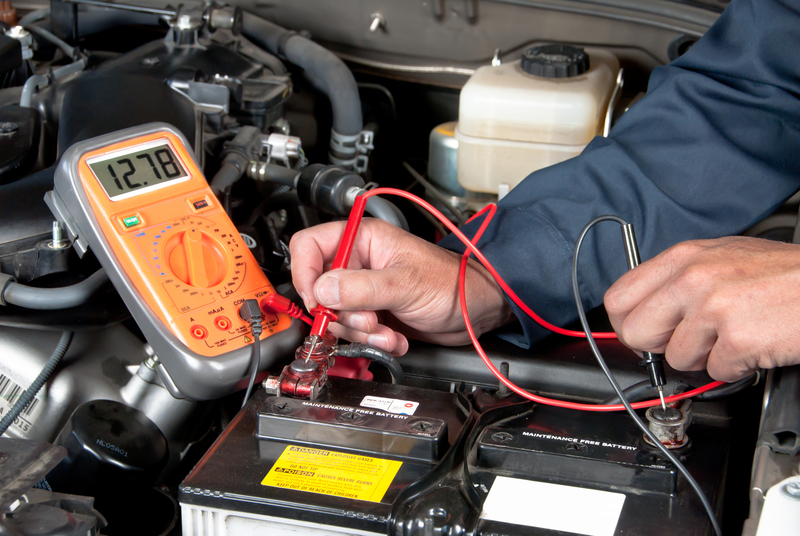Best Practices for Storing Your Freezer During Downtime
Posted on 04/06/2025
Best Practices for Storing Your Freezer During Downtime
Storing your freezer efficiently and safely during periods of inactivity is crucial for maximizing the appliance's lifespan, preventing maintenance issues, and saving energy. Whether you're preparing for an extended holiday, seasonal closure of your business, or simply won't be using your freezer for a while, freezer storage best practices ensure your investment remains in prime condition. This comprehensive guide covers everything you need to know about storing your freezer during downtime.

Why Proper Freezer Storage Matters
Understanding why proper storage is essential during downtime can help you avoid unexpected repairs, food spoilage, and even safety hazards. Here's why storing a freezer during downtime the right way matters:
- Prevents Mold and Mildew: Moisture or food residues can lead to the formation of mold, causing unpleasant odors and potential health risks.
- Reduces Energy Consumption: Unplugging and properly storing your freezer saves on electricity costs and supports eco-friendly practices.
- Extends Appliance Lifespan: Proper care during periods of inactivity reduces wear and tear on internal components.
- Protects from Pests: Cleaning and sealing a freezer properly prevents rodent or insect infestations.
Are You Storing Your Freezer or Its Contents?
It's important to clarify if you are storing the freezer appliance itself or the food inside the freezer. This guide focuses on the former -- the best practices for freezer storage when the appliance will not be in use for an extended time.
How to Prep Your Freezer for Downtime
Implementing a strategic shutdown can prevent expensive issues later. Here are crucial steps before putting your freezer into storage:
1. Remove All Food
Never leave food inside an idle freezer, even non-perishable items. Food left unattended can spoil, leak, and create a breeding ground for bacteria and foul odors.
- Transfer perishables to another appliance or use them up.
- Donate frozen goods you can't consume to a local shelter or food bank, if possible.
2. Unplug and Defrost
Once empty, unplug the freezer. Consult your owner's manual for the best way to defrost; some models have a dedicated setting. Place towels or a tray beneath the door to catch meltwater.
- Quick Tip: Leave the door open during defrosting to speed up the process and permit air circulation.
- Never use sharp tools to chip away ice; this can damage the lining or internal mechanisms.
3. Thorough Cleaning Is Non-Negotiable
Sanitize your freezer with warm soapy water or a mix of water and baking soda. Clean all shelves, drawers, and rubber gaskets.
- Remove drawers and racks to air dry completely.
- Pay special attention to drain holes and drip trays. These can harbor stagnant water and bacteria.
4. Dry Completely
Moisture left behind can fuel mold and mildew. Wipe all surfaces thoroughly and leave the freezer open for several hours--or even overnight--to guarantee dryness.
5. Deodorize the Interior
Before storage, neutralize odors by:
- Placing an open box of baking soda or activated charcoal inside.
- Alternatively, use a sachet of dry coffee grounds for a fresh scent.
6. Secure Doors and Moving Parts
Prevent accidental closing (which can trap moisture and cause musty odors) by:
- Wedge the door open a small amount with a rolled-up towel or secure with a child safety strap.
- If storing the freezer upright, ensure it cannot tip over.
7. Move the Freezer with Care
If relocating the appliance:
- Consult the user manual for safe moving practices.
- Avoid laying the freezer on its side; if you must, let it rest upright for several hours before reconnecting power to allow compressor fluids to settle.
Choosing the Right Storage Space for Your Freezer
Not all locations are ideal for freezer storage during downtime. Consider these important factors:
1. Climate and Temperature
Best practice is to store a freezer in a cool, dry space. Excessive heat, cold, or humidity can harm internal components, wiring, or seals.
- *Climate-controlled storage units are ideal for long-term storage.*
- *Avoid outdoor sheds during extreme seasons.*
2. Elevation and Placement
Place your freezer on a level surface and slightly elevated off the ground to prevent water damage or condensation-related rusting.
- *Consider using a pallet or a foam block under the appliance.*
- Never block ventilation grilles or compressor units.
3. Security and Pest Control
Secure the storage area against rodents and insects. If using a storage facility, verify their pest management protocol.
- *Seal gaps and cracks around doors or windows.*
- *Avoid storing near known pest entry points.*
Ongoing Care: Periodic Checks During Downtime
Even when not in active use, it's recommended to check on your freezer every few weeks or months, especially for long-term storage. Key actions include:
- Inspect for condensation: Wipe away any moisture to prevent internal rust.
- Monitor for odors: If mustiness develops, refresh the deodorizer and re-clean as necessary.
- Examine door seals: Make sure gaskets remain bubble- and tear-free for a tight seal upon reactivation.
Preparing Your Freezer for Use After Downtime
Once you're ready to bring your freezer back into action, follow these best practices:
1. Visual Inspection
*Check exterior and interior for dust, insects, or signs of mold. Address any issues before powering on.*
2. Clean Again
*Even if cleaned before storage, another wipe-down with a mild cleaner will remove dust and potential allergens.*
3. Plug-In and Wait
*Allow the freezer to stand upright for several hours (if it's been moved), then reconnect power. Let it cool to the desired temperature before reloading food.*
4. Check Functionality
*Test shelves, door seals, lights, and temperature controls to ensure everything is operating correctly.*
Expert Tips for Freezer Storage Success
- Label and Date Everything: If storing food in freezers that remain plugged in, label packages with dates to manage freezer burn and discard old items.
- Maintain Door Gaskets: Use a thin layer of petroleum jelly on rubber gasket seals before and after extended downtime to prevent drying and cracking.
- Store Upright When Possible: Upright storage prevents oil from leaving the compressor, which could cause startup failure.
- Do Not Store Heavy Items on Top: Excess weight can warp casing or crush delicate controls.
- Keep Deodorizer Inside: Replace baking soda or charcoal every few months to keep odors at bay.
Common Mistakes to Avoid When Storing Freezers
- Leaving Moisture Inside: Trapped water can rapidly lead to mold and rust -- ensure your freezer is bone dry before closing up.
- Locking the Door Completely: This may cause a musty or foul-smelling interior. Always keep the door slightly ajar.
- Ignoring Location Hazards: Placing a freezer dead-center under a leaky roof or by a humid wall cuts its lifespan dramatically.
- Storing on Bare Concrete: Concrete can transfer moisture upward; always elevate the appliance slightly.
- Powering On Shortly After Relocating: If the unit was transported on its side or back, wait a recommended 4-24 hours before plugging it in.
Freezer Storage for Special Situations
*Some scenarios require extra caution:*
Short-Term Storage (Less Than a Month)
- Still empty and clean the freezer, but door can be left just slightly open, especially in a dry, indoor location.
- For businesses, consider leaving the freezer plugged in if very frequent checks are difficult and storing temperature-critical items is essential.
Long-Term Storage (Several Months or More)
- Full defrost and deep clean are essential to prevent lasting foul odors and appliance malfunctions.
- In humid climates, use a rechargeable silica gel pack to absorb excess moisture.
- Take photos of the unit and serial number for your records, especially for warranty or insurance purposes.

FAQs About Storing Your Freezer During Downtime
How long can I leave a freezer unused?
*A properly prepared and cleaned freezer can be safely left unused for several months -- even up to a year -- in the right conditions.*
What causes bad smells in stored freezers?
*Residual food, moisture, and lack of airflow are the main culprits. Always clean and prop the door open. Store baking soda or silica packets inside for added protection.*
Can I store a freezer outside during downtime?
*Ideally, no. Outdoor conditions introduce temperature swings, humidity, and pests that can damage insulation or electronics. Only do so if the freezer is rated for outdoor use, and provide a weatherproof cover and secure base.*
Is it safe to lock the freezer door shut during storage?
*It's not recommended because a completely sealed environment encourages mold and odors. Instead, secure the door so it's slightly ajar.*
Conclusion: The Key to Worry-Free Freezer Storage
With a little preparation and ongoing care, your freezer can withstand even extended periods of inactivity without compromising functionality or hygiene. By following these best practices for storing your freezer during downtime, you safeguard your appliance's longevity, protect against costly repairs, and ensure a smooth return to service when you need it.
Remember: A clean, dry, and well-ventilated freezer is always ready for action--no matter how long the downtime.
Commit to these freezer storage guidelines to enjoy peace of mind and a fresh, efficient appliance for years to come!



